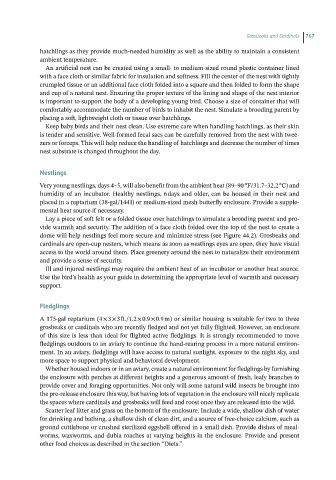Page 764 - Hand rearing birds second
P. 764
Grosbeaks and Cardinals 767
hatchlings as they provide much‐needed humidity as well as the ability to maintain a consistent
ambient temperature.
An artificial nest can be created using a small‐ to medium‐sized round plastic container lined
with a face cloth or similar fabric for insulation and softness. Fill the center of the nest with tightly
crumpled tissue or an additional face cloth folded into a square and then folded to form the shape
and cup of a natural nest. Ensuring the proper texture of the lining and shape of the nest interior
is important to support the body of a developing young bird. Choose a size of container that will
comfortably accommodate the number of birds to inhabit the nest. Simulate a brooding parent by
placing a soft, lightweight cloth or tissue over hatchlings.
Keep baby birds and their nest clean. Use extreme care when handling hatchlings, as their skin
is tender and sensitive. Well‐formed fecal sacs can be carefully removed from the nest with twee-
zers or forceps. This will help reduce the handling of hatchlings and decrease the number of times
nest substrate is changed throughout the day.
Nestlings
Very young nestlings, days 4–5, will also benefit from the ambient heat (89–90 °F/31.7–32.2 °C) and
humidity of an incubator. Healthy nestlings, 6 days and older, can be housed in their nest and
placed in a reptarium (38‐gal/144 l) or medium‐sized mesh butterfly enclosure. Provide a supple-
mental heat source if necessary.
Lay a piece of soft felt or a folded tissue over hatchlings to simulate a brooding parent and pro-
vide warmth and security. The addition of a face cloth folded over the top of the nest to create a
dome will help nestlings feel more secure and minimize stress (see Figure 44.2). Grosbeaks and
cardinals are open‐cup nesters, which means as soon as nestlings eyes are open, they have visual
access to the world around them. Place greenery around the nest to naturalize their environment
and provide a sense of security.
Ill and injured nestlings may require the ambient heat of an incubator or another heat source.
Use the bird’s health as your guide in determining the appropriate level of warmth and necessary
support.
Fledglings
A 175‐gal reptarium (4 × 3 × 3 ft./1.2 × 0.9 × 0.9 m) or similar housing is suitable for two to three
grosbeaks or cardinals who are recently fledged and not yet fully flighted. However, an enclosure
of this size is less than ideal for flighted active fledglings. It is strongly recommended to move
fledglings outdoors to an aviary to continue the hand‐rearing process in a more natural environ-
ment. In an aviary, fledglings will have access to natural sunlight, exposure to the night sky, and
more space to support physical and behavioral development.
Whether housed indoors or in an aviary, create a natural environment for fledglings by furnishing
the enclosure with perches at different heights and a generous amount of fresh, leafy branches to
provide cover and foraging opportunities. Not only will some natural wild insects be brought into
the pre‐release enclosure this way, but having lots of vegetation in the enclosure will nicely replicate
the spaces where cardinals and grosbeaks will feed and roost once they are released into the wild.
Scatter leaf litter and grass on the bottom of the enclosure. Include a wide, shallow dish of water
for drinking and bathing, a shallow dish of clean dirt, and a source of free‐choice calcium, such as
ground cuttlebone or crushed sterilized eggshell offered in a small dish. Provide dishes of meal-
worms, waxworms, and dubia roaches at varying heights in the enclosure. Provide and present
other food choices as described in the section “Diets.”

